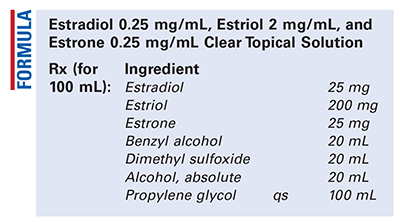US Pharm. 2018;43(9):47-48.

Method of Preparation: Calculate the quantity of each ingredient for the amount to be prepared. Accurately weigh or measure each ingredient. Add the estradiol, estriol, and estrone to the previously combined benzyl alcohol, dimethyl sulfoxide, and absolute alcohol; mix well. Add sufficient propylene glycol to final volume and mix well. Package and label.
Use: This preparation has been used in bioidentical hormone replacement therapy.
Packaging: Package in a topical dosing device or in suitable syringes (without needles) for accurate dosing.
Labeling: Keep out of reach of children. Discard after ____ [time period]. Apply exact dose topically as directed. For external use.
Stability: A beyond-use date of up to 6 months may be used for this preparation.1
Quality Control: Quality-control assessment can include weight/volume, specific gravity, active drug assay, color, clarity, rheologic properties/pourability, physical observation, and physical stability (discoloration, foreign materials, gas formation, mold growth).2
Discussion: Estradiol (oestradiol, beta-estradiol, C18H24O2, MW 272.38) occurs as white or creamy-white, odorless, hygroscopic, small crystals or as a crystalline powder. It is practically insoluble in water, but it is soluble 1 g in 28 mL of alcohol. Estradiol is sparingly soluble in vegetable oils. It should be stored in airtight containers at controlled room temperature and should be protected from light.3
Estriol is a naturally occurring estrogen. It occurs as a crystalline powder that is practically insoluble in water but is soluble in alcohol and vegetable oils.4,5
Estrone is a naturally occurring steroidal estrogen. It occurs as small, white crystals or as a white to creamy-white, crystalline powder that is odorless and practically insoluble in water. Estrone is soluble to the extent of 4 mg/mL in alcohol, and it is soluble in vegetable oils.5,6
Benzyl alcohol (C7H8O, MW 108.14) is an antimicrobial preservative, disinfectant, and solvent. As a solubilizer, it is used at a 5% concentration. Benzyl alcohol is a clear, colorless, oily liquid that has a faint, aromatic odor and a sharp, burning taste. It has a specific gravity of about 1.045; it is soluble 1 g in 25 mL of water at 25°C.7
Dimethyl sulfoxide (DMSO, sulfinylbis-methane, methyl sulfoxide, (CH3)2SO, MW 78.14) occurs as a clear, colorless, hygroscopic liquid with a bittersweet taste and faint to no odor. It boils at about 190°C and freezes at about 18.55°C. Dimethyl sulfoxide is an aprotic low-vapor-pressure dipolar solvent that has penetration-enhancing properties. It is miscible with water, most aromatic and halogenated hydrocarbons, alcohols, ketones, esters, and most sulfur- and nitrogen-containing compounds.8
Absolute alcohol (ethanol, C2H6O, MW 46.07) occurs as a clear, colorless, mobile, volatile liquid with a characteristic odor, and it produces a burning sensation on the tongue. Absolute alcohol is readily volatilized, even at low temperatures, and it boils at about 78°C. It is flammable and is miscible with water and with practically all organic solvents. Absolute alcohol should be preserved in tight containers and protected from light.1
Propylene glycol (C3H8O2) occurs as a clear, colorless, viscous, practically odorless liquid with a sweet taste somewhat resembling glycerin. It has a specific gravity of 1.038 g/mL, and it is miscible with acetone, 95% ethanol, glycerin, and water. Because propylene glycol is hygroscopic, it should be stored in an airtight container and protected from light.9
REFERENCES
1. U.S. Pharmacopeia/National Formulary [current revision]. Rockville, MD: U.S. Pharmacopeial Convention, Inc; August 2018.
2. Allen LV Jr. Standard operating procedure for performing physical quality assessment of oral and topical liquids. IJPC. 1999;3:146-147.
3. McEvoy GK, ed. AHFS Drug Information 2016. Bethesda, MD: American Society of Health-System Pharmacists; 2016:3168-3172.
4. Reynolds JE, ed. Martindale: The Extra Pharmacopoeia. 30th ed. London, England: Pharmaceutical Press; 1993:1192.
5. Hardman JG, Limbird LE. Goodman & Gilman’s The Pharmacological Basis of Therapeutics. 9th ed. New York, NY: McGraw-Hill; 1996:1411-1437.
6. Lacy C, Armstrong LL, Ingrim NB, Lance LL. Drug Information Handbook. 4th ed. Hudson, OH: Lexi-Comp, Inc; 1996:451-452.
7. Quinn ME. Benzyl alcohol. In: Sheskey PJ, Cook WG, Cable CG, eds. Handbook of Pharmaceutical Excipients. 8th ed. London, England: Pharmaceutical Press; 2017:105-108.
8. Dimethyl sulfoxide product information. Slidell, LA: Gaylord Chemical Co; 2018.
9. Driver S. Propylene glycol. In: Sheskey PJ, Cook WG, Cable CG, eds. Handbook of Pharmaceutical Excipients. 8th ed. London, England: Pharmaceutical Press; 2017:795-798.
To comment on this article, contact rdavidson@uspharmacist.com.






